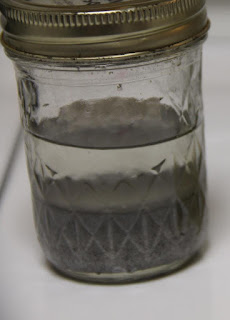Leigh made some pretty tasty-and-leavened-looking biscuits with her extracted carbonate (and with straight wood ash), but noted that they didnt rise quite as well as the control biscuit (which had baking soda). There were also a few unanswered questions on the chemistry involved, so we wanted to follow our nerdy instincts and dive into the nitty gritty of whats happening at the molecular level.
First issue: what is actually being extracted from the wood ashes? Carbonates, we suspect, but is that it? In our minds, theres a controversy, since the process of extracting carbonates for leavening sounds an awful lot like the process of extracting lye (potassium hydroxide, KOH, in this case) for soap making. Were especially keen on figuring this out because if both hydroxides and carbonates are present, it will change our biscuit recipe (specifically, well have to add more acid to get the leavening effect). Lets compare some descriptions.
The very cool Caveman Chemistry website says that the major components of wood ashes are potassium and sodium carbonates, but says this of the extract:
"It contains all of the soluble materials which were present in the the ashes to begin with. This could include sodium and potassium chlorides, sulfates, hydroxides, and carbonates."So, it sounds like both carbonates and hydroxides could be present. Another account of potash and pearlash production from 1866 is generally consistent with that (despite a distinct lack of cavemen in 19th century North America), but doesnt mention hydroxides:
"Carbonate of potash is generally obtained from wood ashes...the soluble constituents of the ashes are the carbonate, sulphate, phosphate, and silicate of potash and chlorides of potassium and sodium. The insoluble constituents are carbonate and subphosphate of lime, alumina, silica, the oxide of iron and manganese, and a dark carbonaceous matter."
That same account also describes the process for preparing the potash and pearlash:
"In America, the ashes are lixiviated [extracted] in barrels with lime, and the solution evaporated in large iron pots or kettles, until the mass has become a black color and the consistency of brown sugar. In this state it is called, by American manufacturers, black salts. ... To make the substance called pearlash, the mass called black salts...is transferred from the kettle to a large oven-shaped furnace, constructed so that the flame is made to play over the alkaline mass. ... The ignition is in this way continued until the combustible impurities are burnt out, and the mass, from being black, becomes dirty bluish-white, having somewhat of a pearly lustre, whence the name pearlash. The coloring matter is probably in this case manganate of potash."In a process flow diagram, it would look something like this:
 |
| Other soluble minerals (OSM) seemed like a better acronym than Minerals of Unusual Solubility (MOUS). (Warning: obscure pop culture reference.) You can buy pure potassium carbonate these days, and its bright white. To visualize the color of pearl ash, think of this color, but very faint. |
So, no mention of potassium hydroxide in the old-time production, but that might be because of the production method. The CO2 in the combustion gases that are passing over the black salts reacts with KOH to make KHCO3 (or to make H2O and K2CO3); any KHCO3 produced decomposes to K2CO3 in the heat. So basically, if hydroxides are extracted into the ash water, they dont make it into the pearlash.
But, compare the process of making ash water for leavening with any of several similar descriptions of the process for preparing lye for making soap. For example, this one:
"Traditionally, one uses an old wooden barrel or lye hopper for this, even hollow treetrunks in some areas. ... In the bottom, put a filter made from a couple of inch depth of twigs, and the same again of straw or hay. This helps ensure the lye comes off moderately clear. Stand the lye barrel up high enough to get a container underneath...and fill it up with those ashes. Add water. ... Leave it all overnight...[then] let the lye run out into your container."
Other descriptions call for adding lime (or slaked lime), which we noted increases the hydroxide yield by converting carbonates to hydroxides by the following reaction:
Ca(OH)2 + K2CO3 = 2 KOH+ CaCO3
There is also a journal article in the peer-reviewed literature, which claims the ratio of hydroxides to carbonates in their crude ash extracts is 92-to-8, and more anecdotal observations that carbonates dont work very well for making soap (but ash water does) and that crude ash extract by itself doesnt do much leavening. Therefore, it seems very likely that the crude ash water extract contains an appreciable amount of hydroxides along with the carbonates.
So theres the theory--probably both carbonates and hydroxides are present in the ash water. Fortunately, we dont have to just sit around, dealing in hypotheticals. We can experimentally measure the amounts of carbonate and hydroxide in the ash water through the magic of titration. (If youve suffered through an analytical chemistry class in college, we hope you didnt just throw up in your mouth a little bit.)
 |
| O ash water, what mysteries containest thou for us to unravel by the labor of titration? |
Well give you a few days to stew over that and hit you in a few days with a chemistry-dense post interspersed with colorful pictures.


0 komentar:
Posting Komentar